airbag RENAULT MASTER 2018 Owners Manual
[x] Cancel search | Manufacturer: RENAULT, Model Year: 2018, Model line: MASTER, Model: RENAULT MASTER 2018Pages: 290, PDF Size: 7.1 MB
Page 7 of 290
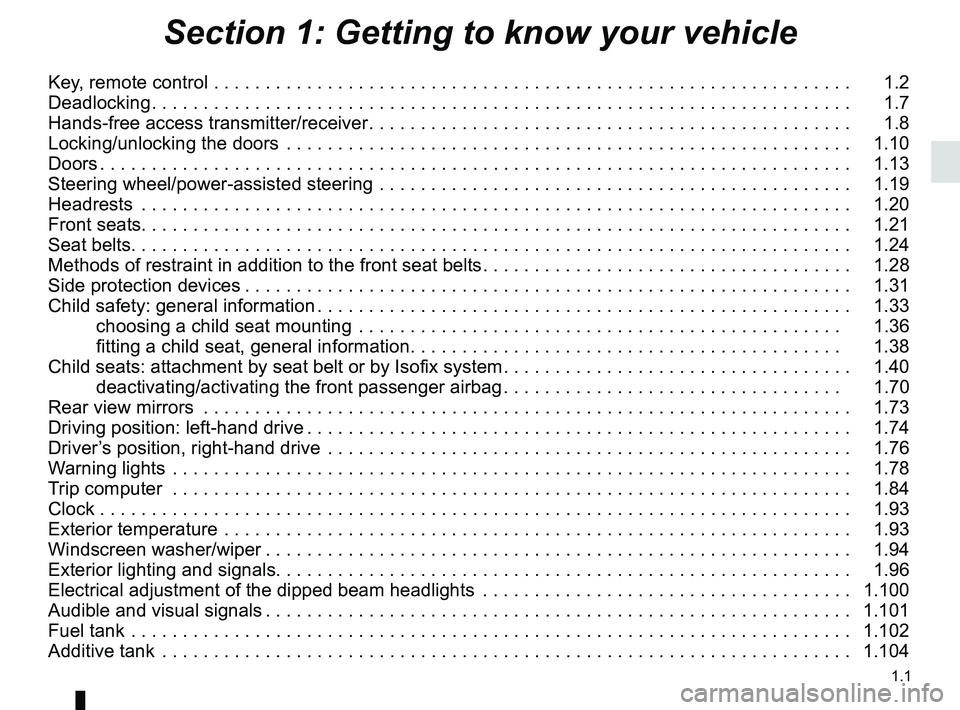
1.1
Section 1: Getting to know your vehicle
Key, remote control . . . . . . . . . . . . . . . . . . . . . . . . . . . . . . . . . . . .\
. . . . . . . . . . . . . . . . . . . . . . . . . . 1.2
Deadlocking . . . . . . . . . . . . . . . . . . . . . . . . . . . . . . . . . . . . \
. . . . . . . . . . . . . . . . . . . . . . . . . . . . . . . . 1.7
Hands-free access transmitter/receiver . . . . . . . . . . . . . . . . . . . . . . . . . . . . . . . . . . . . \
. . . . . . . . . . . 1.8
Locking/unlocking the doors . . . . . . . . . . . . . . . . . . . . . . . . . . . . . . . . . . . .\
. . . . . . . . . . . . . . . . . . . 1.10
Doors . . . . . . . . . . . . . . . . . . . . . . . . . . . . . . . . . . . . \
. . . . . . . . . . . . . . . . . . . . . . . . . . . . . . . . . . . . . 1.13
Steering wheel/power-assisted steering . . . . . . . . . . . . . . . . . . . . . . . . . . . . . . . . . . . .\
. . . . . . . . . . 1.19
Headrests . . . . . . . . . . . . . . . . . . . . . . . . . . . . . . . . . . . .\
. . . . . . . . . . . . . . . . . . . . . . . . . . . . . . . . . 1.20
Front seats. . . . . . . . . . . . . . . . . . . . . . . . . . . . . . . . . . . . \
. . . . . . . . . . . . . . . . . . . . . . . . . . . . . . . . . 1.21
Seat belts. . . . . . . . . . . . . . . . . . . . . . . . . . . . . . . . . . . . \
. . . . . . . . . . . . . . . . . . . . . . . . . . . . . . . . . . 1.24
Methods of restraint in addition to the front seat belts . . . . . . . . . . . . . . . . . . . . . . . . . . . . . . . . . . . . 1.28
Side protection devices . . . . . . . . . . . . . . . . . . . . . . . . . . . . . . . . . . . . \
. . . . . . . . . . . . . . . . . . . . . . . 1.31
Child safety: general information . . . . . . . . . . . . . . . . . . . . . . . . . . . . . . . . . . . . \
. . . . . . . . . . . . . . . . 1.33 choosing a child seat mounting . . . . . . . . . . . . . . . . . . . . . . . . . . . . . . . . . . . .\
. . . . . . . . . . . 1.36
fitting a child seat, general information . . . . . . . . . . . . . . . . . . . . . . . . . . . . . . . . . . . . \
. . . . . . 1.38
Child seats: attachment by seat belt or by Isofix system . . . . . . . . . . . . . . . . . . . . . . . . . . . . . . . . . . 1.40 deactivating/activating the front passenger airbag . . . . . . . . . . . . . . . . . . . . . . . . . . . . . . . . . 1.70
Rear view mirrors . . . . . . . . . . . . . . . . . . . . . . . . . . . . . . . . . . . .\
. . . . . . . . . . . . . . . . . . . . . . . . . . . 1.73
Driving position: left-hand drive . . . . . . . . . . . . . . . . . . . . . . . . . . . . . . . . . . . . \
. . . . . . . . . . . . . . . . . 1.74
Driver’s position, right-hand drive . . . . . . . . . . . . . . . . . . . . . . . . . . . . . . . . . . . .\
. . . . . . . . . . . . . . . 1.76
Warning lights . . . . . . . . . . . . . . . . . . . . . . . . . . . . . . . . . . . .\
. . . . . . . . . . . . . . . . . . . . . . . . . . . . . . 1.78
Trip computer . . . . . . . . . . . . . . . . . . . . . . . . . . . . . . . . . . . .\
. . . . . . . . . . . . . . . . . . . . . . . . . . . . . . 1.84
Clock . . . . . . . . . . . . . . . . . . . . . . . . . . . . . . . . . \
. . . . . . . . . . . . . . . . . . . . . . . . . . . . . . . . . . . . . . . . 1.93
Exterior temperature . . . . . . . . . . . . . . . . . . . . . . . . . . . . . . . . . . . .\
. . . . . . . . . . . . . . . . . . . . . . . . . 1.93
Windscreen washer/wiper . . . . . . . . . . . . . . . . . . . . . . . . . . . . . . . . . . . . \
. . . . . . . . . . . . . . . . . . . . . 1.94
Exterior lighting and signals. . . . . . . . . . . . . . . . . . . . . . . . . . . . . . . . . . . . \
. . . . . . . . . . . . . . . . . . . . 1.96
Electrical adjustment of the dipped beam headlights . . . . . . . . . . . . . . . . . . . . . . . . . . . . . . . . . . . .\
1.100
Audible and visual signals . . . . . . . . . . . . . . . . . . . . . . . . . . . . . . . . . . . . \
. . . . . . . . . . . . . . . . . . . . . 1.101
Fuel tank . . . . . . . . . . . . . . . . . . . . . . . . . . . . . . . . . . . .\
. . . . . . . . . . . . . . . . . . . . . . . . . . . . . . . . . . 1.102
Additive tank . . . . . . . . . . . . . . . . . . . . . . . . . . . . . . . . . . . .\
. . . . . . . . . . . . . . . . . . . . . . . . . . . . . . . 1.104
Page 35 of 290
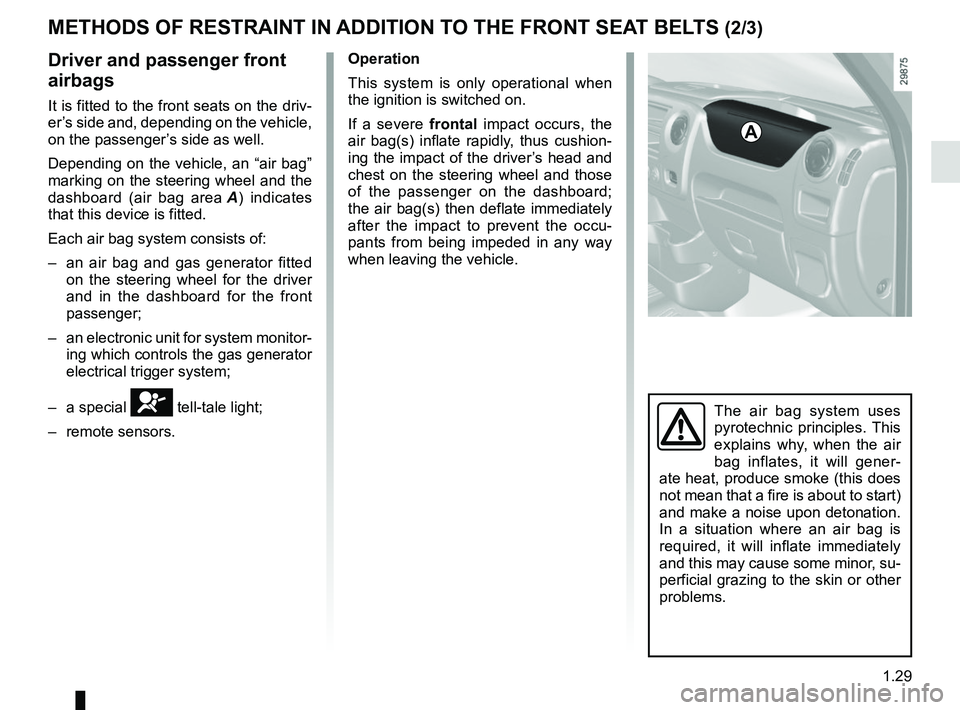
1.29
METHODS OF RESTRAINT IN ADDITION TO THE FRONT SEAT BELTS (2/3)
Driver and passenger front
airbags
It is fitted to the front seats on the driv-
er’s side and, depending on the vehicle,
on the passenger’s side as well.
Depending on the vehicle, an “air bag”
marking on the steering wheel and the
dashboard (air bag area A) indicates
that this device is fitted.
Each air bag system consists of:
– an air bag and gas generator fitted on the steering wheel for the driver
and in the dashboard for the front
passenger;
– an electronic unit for system monitor- ing which controls the gas generator
electrical trigger system;
– a special
å tell-tale light;
– remote sensors. Operation
This system is only operational when
the ignition is switched on.
If a severe frontal impact occurs, the
air bag(s) inflate rapidly, thus cushion-
ing the impact of the driver’s head and
chest on the steering wheel and those
of the passenger on the dashboard;
the air bag(s) then deflate immediately
after the impact to prevent the occu-
pants from being impeded in any way
when leaving the vehicle.
A
The air bag system uses
pyrotechnic principles. This
explains why, when the air
bag inflates, it will gener-
ate heat, produce smoke (this does
not mean that a fire is about to start)
and make a noise upon detonation.
In a situation where an air bag is
required, it will inflate immediately
and this may cause some minor, su-
perficial grazing to the skin or other
problems.
Page 52 of 290
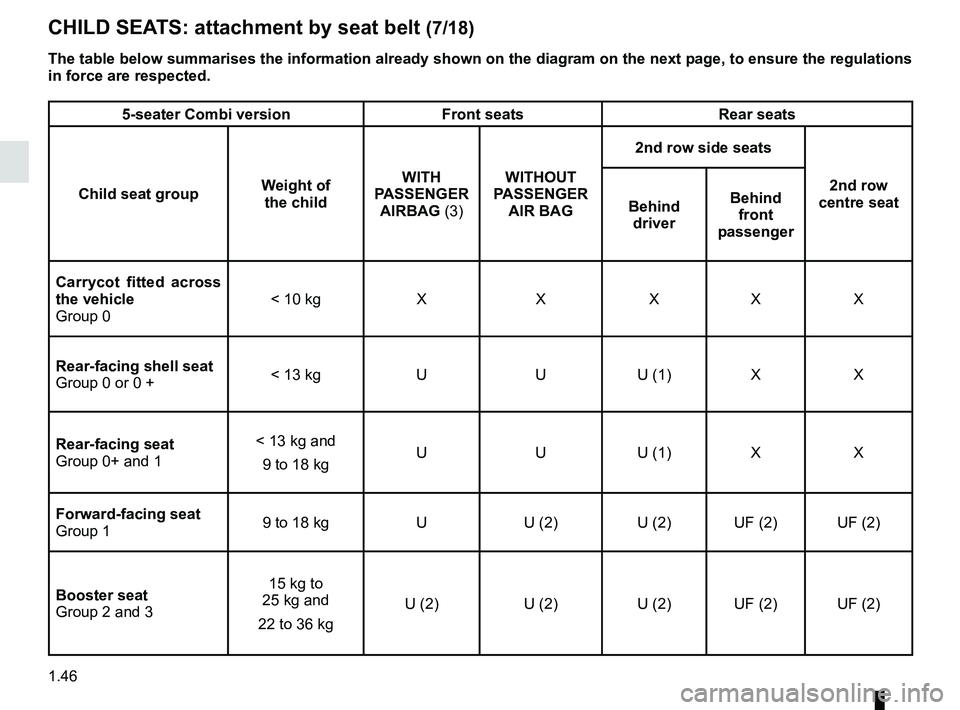
1.46
CHILD SEATS: attachment by seat belt (7/18)
5-seater Combi versionFront seatsRear seats
Child seat group Weight of
the child WITH
PASSENGER AIRBAG (3) WITHOUT
PASSENGER AIR BAG 2nd row side seats
2nd row
centre seat
Behind
driver Behind
front
passenger
Carrycot fitted across
the vehicle
Group 0 < 10 kg
XXXX X
Rear-facing shell seat
Group 0 or 0 + < 13 kg
UUU (1) XX
Rear-facing seat
Group 0+ and 1 < 13 kg and
9 to 18 kg U
UU (1) XX
Forward-facing seat
Group 1 9 to 18 kg
UU (2) U (2) UF (2) UF (2)
Booster seat
Group 2 and 3 15 kg to
25 kg and
22 to 36 kg U (2)
U (2)U (2) UF (2) UF (2)
The table below summarises the information already shown on the diagram \
on the next page, to ensure the regulations
in force are respected.
Page 53 of 290
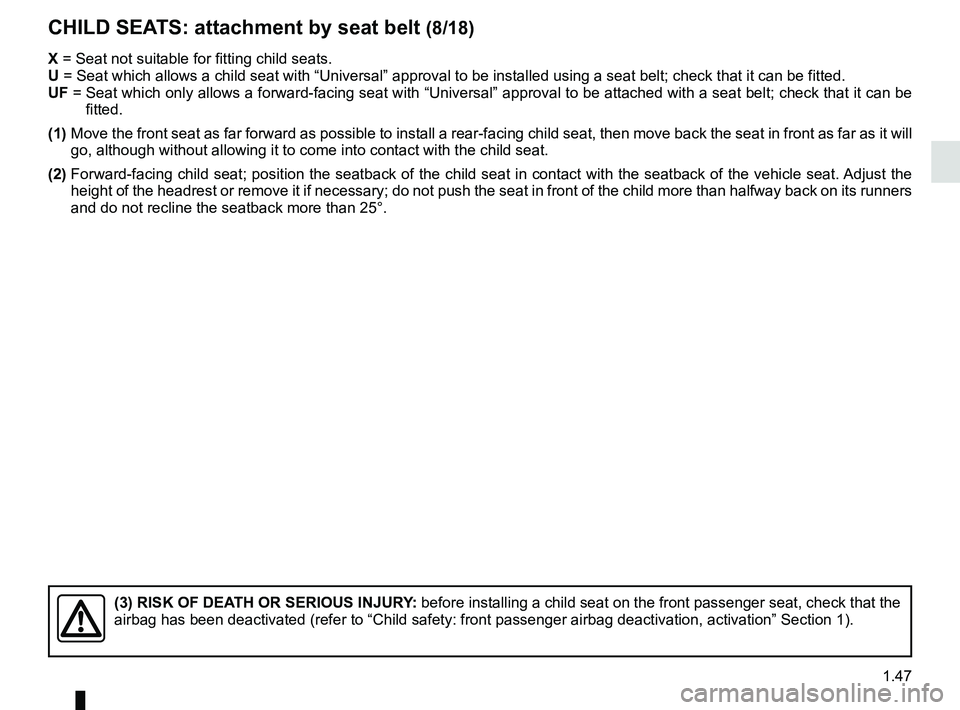
1.47
CHILD SEATS: attachment by seat belt (8/18)
(3) RISK OF DEATH OR SERIOUS INJURY: before installing a child seat on the front passenger seat, check that \
the
airbag has been deactivated (refer to “Child safety: front passenger\
airbag deactivation, activation” Section 1).
X = Seat not suitable for fitting child seats.
U = Seat which allows a child seat with “Universal” approval to be ins\
talled using a seat belt; check that it can be fitted.
UF = Seat which only allows a forward-facing seat with “Universal” appr\
oval to be attached with a seat belt; check that it can be
fitted.
(1) Move the front seat as far forward as possible to install a rear-facing \
child seat, then move back the seat in front as far as it will
go, although without allowing it to come into contact with the child sea\
t.
(2) Forward-facing child seat; position the seatback of the child seat in co\
ntact with the seatback of the vehicle seat. Adjust the
height of the headrest or remove it if necessary; do not push the seat i\
n front of the child more than halfway back on its runn ers
and do not recline the seatback more than 25°.
Page 56 of 290
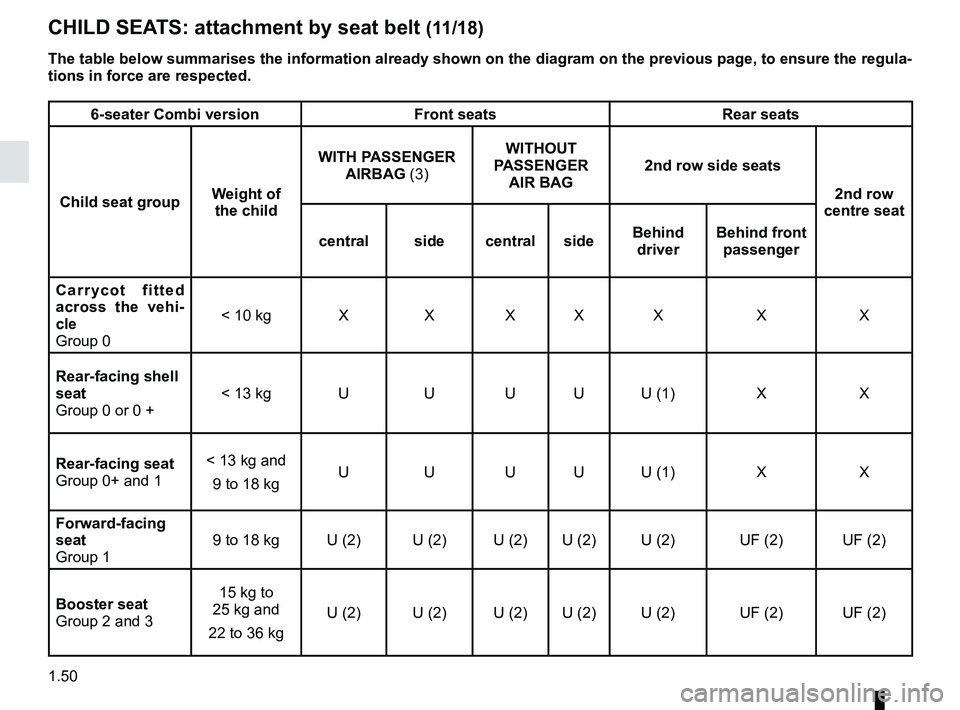
1.50
CHILD SEATS: attachment by seat belt (11/18)
6-seater Combi versionFront seatsRear seats
Child seat group Weight of
the child WITH PASSENGER
AIRBAG (3) WITHOUT
PASSENGER AIR BAG 2nd row side seats
2nd row
centre seat
central side central side Behind
driver Behind front
passenger
Carrycot fitted
across the vehi-
cle
Group 0 < 10 kg X X X X X
XX
Rear-facing shell
seat
Group 0 or 0 + < 13 kg U U U U U (1)
XX
Rear-facing seat
Group 0+ and 1 < 13 kg and
9 to 18 kg U U U U U (1)
XX
Forward-facing
seat
Group 1 9 to 18 kg U (2) U (2) U (2) U (2) U (2) UF (2) UF (2)
Booster seat
Group 2 and 3 15 kg to
25 kg and
22 to 36 kg U (2) U (2) U (2) U (2) U (2) UF (2) UF (2)
The table below summarises the information already shown on the diagram \
on the previous page, to ensure the regula-
tions in force are respected.
Page 57 of 290
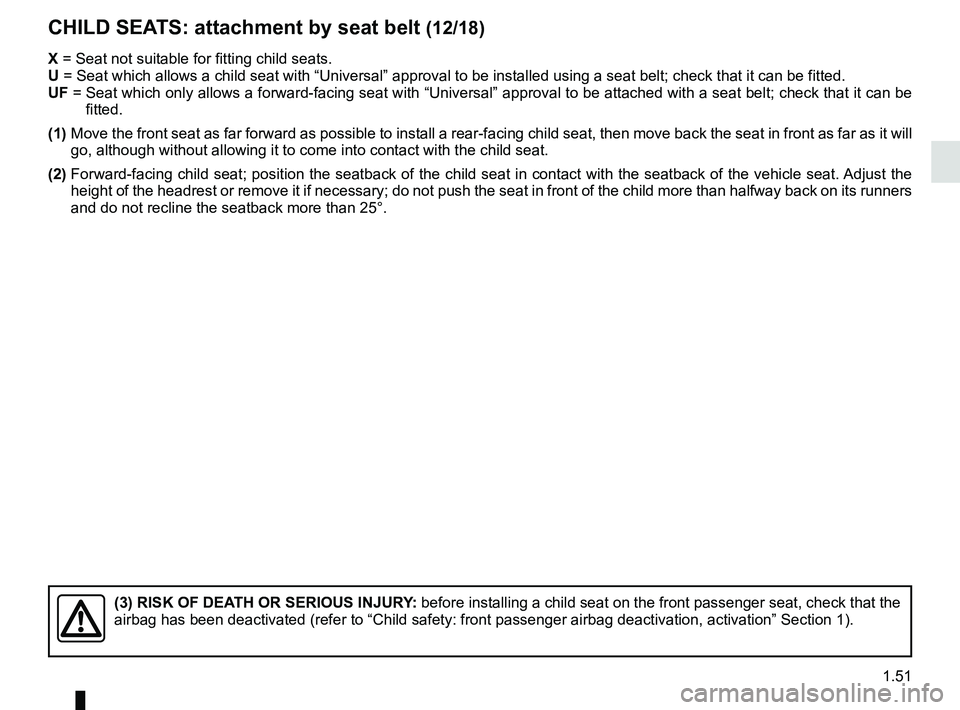
1.51
CHILD SEATS: attachment by seat belt (12/18)
(3) RISK OF DEATH OR SERIOUS INJURY: before installing a child seat on the front passenger seat, check that \
the
airbag has been deactivated (refer to “Child safety: front passenger\
airbag deactivation, activation” Section 1).
X = Seat not suitable for fitting child seats.
U = Seat which allows a child seat with “Universal” approval to be ins\
talled using a seat belt; check that it can be fitted.
UF = Seat which only allows a forward-facing seat with “Universal” appr\
oval to be attached with a seat belt; check that it can be
fitted.
(1) Move the front seat as far forward as possible to install a rear-facing \
child seat, then move back the seat in front as far as it will
go, although without allowing it to come into contact with the child sea\
t.
(2) Forward-facing child seat; position the seatback of the child seat in co\
ntact with the seatback of the vehicle seat. Adjust the
height of the headrest or remove it if necessary; do not push the seat i\
n front of the child more than halfway back on its runn ers
and do not recline the seatback more than 25°.
Page 58 of 290
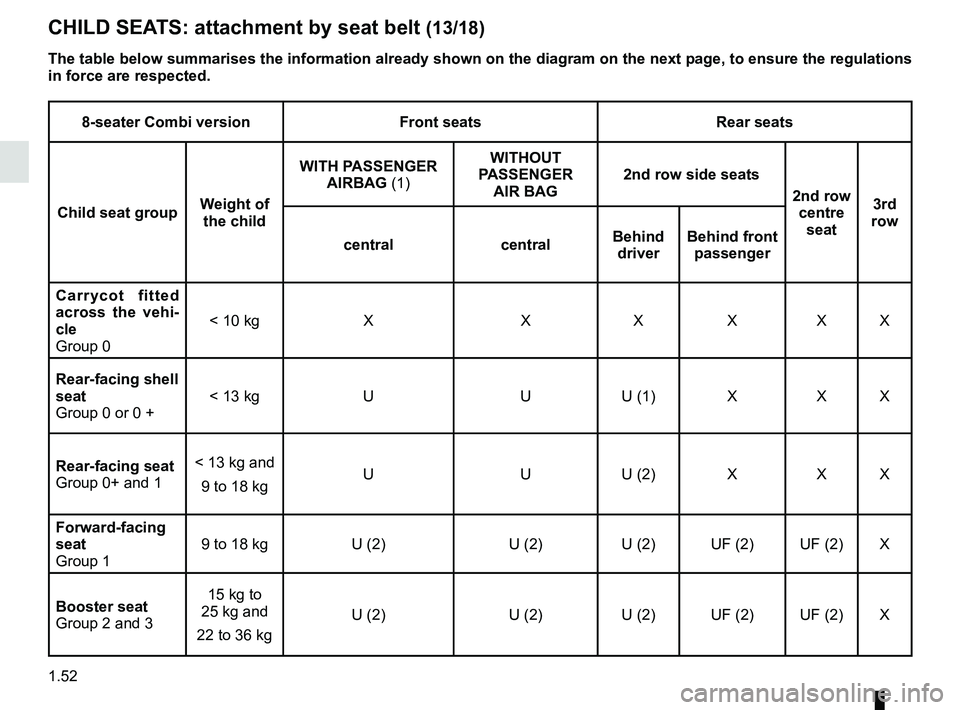
1.52
CHILD SEATS: attachment by seat belt (13/18)
8-seater Combi versionFront seatsRear seats
Child seat group Weight of
the child WITH PASSENGER
AIRBAG (1) WITHOUT
PASSENGER AIR BAG 2nd row side seats
2nd row centre seat 3rd
row
central centralBehind
driver Behind front
passenger
Carrycot fitted
across the vehi-
cle
Group 0 < 10 kg
X XXXX X
Rear-facing shell
seat
Group 0 or 0 + < 13 kg
U UU (1) X X X
Rear-facing seat
Group 0+ and 1 < 13 kg and
9 to 18 kg U
UU (2) X X X
Forward-facing
seat
Group 1 9 to 18 kg
U (2) U (2)U (2) UF (2) UF (2) X
Booster seat
Group 2 and 3 15 kg to
25 kg and
22 to 36 kg U (2)
U (2)U (2) UF (2) UF (2) X
The table below summarises the information already shown on the diagram \
on the next page, to ensure the regulations
in force are respected.
Page 59 of 290
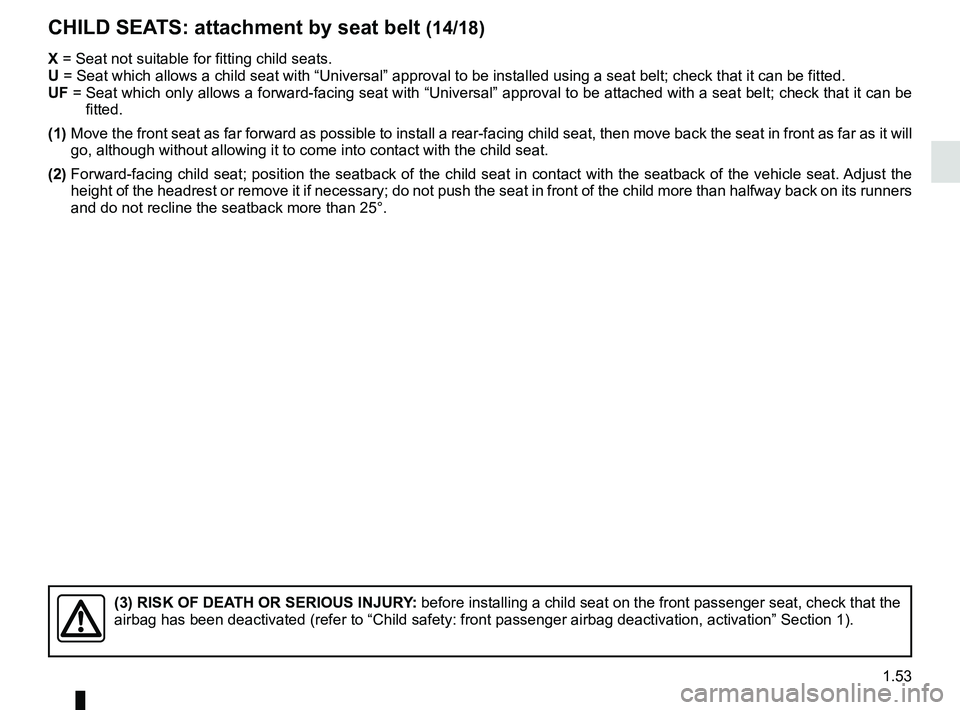
1.53
CHILD SEATS: attachment by seat belt (14/18)
(3) RISK OF DEATH OR SERIOUS INJURY: before installing a child seat on the front passenger seat, check that \
the
airbag has been deactivated (refer to “Child safety: front passenger\
airbag deactivation, activation” Section 1).
X = Seat not suitable for fitting child seats.
U = Seat which allows a child seat with “Universal” approval to be ins\
talled using a seat belt; check that it can be fitted.
UF = Seat which only allows a forward-facing seat with “Universal” appr\
oval to be attached with a seat belt; check that it can be
fitted.
(1) Move the front seat as far forward as possible to install a rear-facing \
child seat, then move back the seat in front as far as it will
go, although without allowing it to come into contact with the child sea\
t.
(2) Forward-facing child seat; position the seatback of the child seat in co\
ntact with the seatback of the vehicle seat. Adjust the
height of the headrest or remove it if necessary; do not push the seat i\
n front of the child more than halfway back on its runn ers
and do not recline the seatback more than 25°.
Page 62 of 290
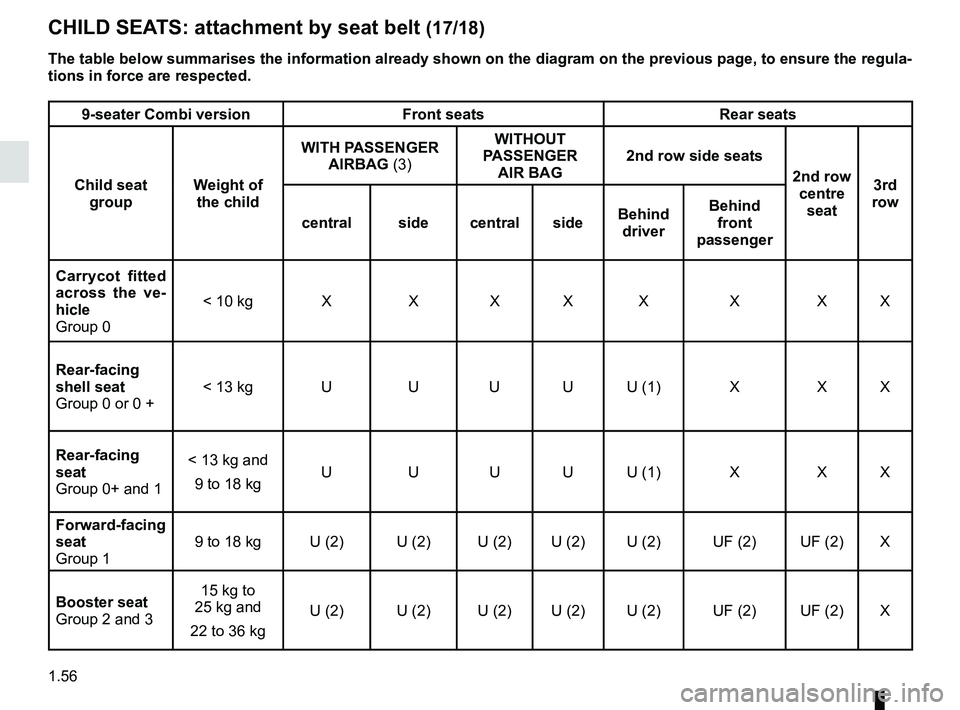
1.56
CHILD SEATS: attachment by seat belt (17/18)
9-seater Combi versionFront seatsRear seats
Child seat group Weight of
the child WITH PASSENGER
AIRBAG (3) WITHOUT
PASSENGER AIR BAG 2nd row side seats
2nd row centre seat 3rd
row
central side central side Behind
driver Behind
front
passenger
Carrycot fitted
across the ve-
hicle
Group 0 < 10 kg X X X X X X X X
Rear-facing
shell seat
Group 0 or 0 + < 13 kg U U U U U (1) X X X
Rear-facing
seat
Group 0+ and 1 < 13 kg and
9 to 18 kg U U U U U (1) X X X
Forward-facing
seat
Group 1 9 to 18 kg U (2) U (2) U (2) U (2) U (2) UF (2) UF (2) X
Booster seat
Group 2 and 3 15 kg to
25 kg and
22 to 36 kg U (2) U (2) U (2) U (2) U (2) UF (2) UF (2) X
The table below summarises the information already shown on the diagram \
on the previous page, to ensure the regula-
tions in force are respected.
Page 63 of 290

1.57
CHILD SEATS: attachment by seat belt (18/18)
(3) RISK OF DEATH OR SERIOUS INJURY: before installing a child seat on the front passenger seat, check that \
the
airbag has been deactivated (refer to “Child safety: front passenger\
airbag deactivation, activation” Section 1).
X = Seat not suitable for fitting child seats.
U = Seat which allows a child seat with “Universal” approval to be ins\
talled using a seat belt; check that it can be fitted.
UF = Seat which only allows a forward-facing seat with “Universal” appr\
oval to be attached with a seat belt; check that it can be
fitted.
(1) Move the front seat as far forward as possible to install a rear-facing \
child seat, then move back the seat in front as far as it will
go, although without allowing it to come into contact with the child sea\
t.
(2) Forward-facing child seat; position the seatback of the child seat in co\
ntact with the seatback of the vehicle seat. Adjust the
height of the headrest or remove it if necessary; do not push the seat i\
n front of the child more than halfway back on its runn ers
and do not recline the seatback more than 25°.